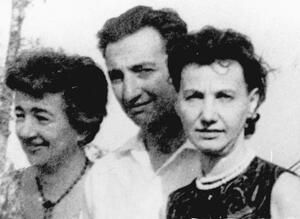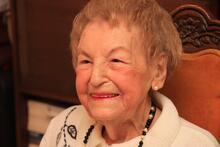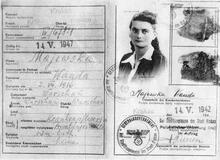Vladka Meed
Vladka Meed, whose given name was Feigele Peltel, served the Jewish underground in the Warsaw Ghetto by passing as a Christian outside its walls. Fluent in Polish and possessing a typical “Aryan” appearance, Meed became a successful underground courier, smuggling weapons across the wall to the Jewish Fighting Organization. Meed came to New York immediately following the war and in 1948 she published a memoir about her experiences, On Both Sides of the Wall, in Yiddish. She lectured widely about the Holocaust and was extremely active in Holocaust education and memorialization. As vice president of the Jewish Labor Committee, she ran the Yiddish Cultural and Welfare Department for many years. She received numerous awards, including the 1993 Hadassah Henrietta Szold Award and the 1995 Elie Wiesel Remembrance Award.
Role in the Jewish Underground
Vladka Meed, whose given name was Feigele Peltel, was a member of the Jewish underground in the Warsaw ghetto from its first days. The daughter of Shlomo and Hanna Peltel, she was born on December 29, 1921 in Warsaw, where she became active in the Zukunft, the youth organization of the S.C., a strong Jewish socialist-democratic party, founded in 1897. The organization was opposed to Zionism and advocated Yiddish language and culture as well as secular Jewish nationalism in the Lit. (Greek) "dispersion." The Jewish community, and its areas of residence, outside Erez Israel.Diaspora.
The title of Meed’s book, On Both Sides of the Wall, refers to how she served in the resistance by passing as a Christian outside the Warsaw ghetto. Meed was a teenager living in Warsaw when the German invasion of Poland began. She had graduated from the Yiddish Folkshul, a secular school where all subjects were taught in Yiddish, with Polish taught only as a second language. However, she had picked up fluent Polish from her younger sister Henia, who had gone to a Polish public school.
She took the name Vladka when she was assigned outside the ghetto, on the “Aryan” side of Warsaw. Because of her typically “Aryan” appearance, fluency in Polish, and resourcefulness, she was a successful underground courier. She not only smuggled weapons across the wall to the Jewish Fighting Organization, the ZOB, established in Warsaw on July 28, 1942, but also helped Jewish children to escape from the ghetto to be sheltered in Christian homes. In addition, she assisted Jews who were in hiding in the city, and established contact with those still surviving in the labor camps and with the partisans in the forest. Her father died of pneumonia in the ghetto, and her mother, sister, and younger brother Chaim were deported to Treblinka and murdered there.
On Both Sides of the Wall
Meed’s book begins with the deportations in Warsaw on July 22, 1942, and the original version ended with the Warsaw Polish Uprising in August 1944 (with a short section on her return to Warsaw after the city’s liberation by the Soviet Army in January 1945). The 1993 English edition, reprinted in 1999 and published by the United States Holocaust Memorial Museum, has an epilogue, “33 Years Later,” which also recounts Meed’s first return visit to Poland, together with her husband.
Meed’s account, which was written soon after the end of World War II, has detailed recollections of people and events that give her book a feeling of immediacy. First published in Yiddish by the Educational Committee of the Workmen’s Circle in New York in 1948, the book was based on twenty-seven articles she had written in Yiddish in 1946–1947 for The Forward. Since then, Meed’s book has also been published in English, Hebrew, Spanish, Japanese, and German. The first English edition was issued by Beit Lohamei ha-Getta’ot(Ghetto Fighters’ House) and Ha-A voluntary collective community, mainly agricultural, in which there is no private wealth and which is responsible for all the needs of its members and their families.kibbutz ha-Me’uhad Publishers in Israel in 1972.
Holocaust Education & Memorialization
Vladka Meed met Czeslaw (Benjamin) Miedzyrzecka, later known as Ben Meed (b. February 19, 1918 in Warsaw), in the underground in Warsaw. They married soon after the end of World War II, and arrived in New York City on May 24, 1946 on the second ship bringing survivors from Europe. Soon afterward, leaders of the Jewish Labor Committee (JLC) and the International Rescue Committee sent her to lecture about her experiences. Her daughter, now Dr. Anna Scherzer, was born in 1948, and her son, Dr. Steven Meed, in 1951.
Meed continued to lecture on the Holocaust, and, together with her husband, was extremely active in Holocaust education and memorialization. As vice president of the JLC, she for many years ran the Yiddish Cultural and Welfare Department and was responsible for a filmstrip and an exhibit on the Warsaw Ghetto uprising. For about ten years she was the JLC’s Yiddish-language commentator on a weekly program on WEVD, the Yiddish radio station in New York.
Meed was also a leader of an effort to create a Holocaust memorial in Battery Park in lower Manhattan in the 1960s. Although the project was ultimately unsuccessful, she was instrumental in having the renowned architect Louis Kahn design a memorial sculpture for the site. She was the chairperson of cultural events for the World Gathering of Jewish Holocaust Survivors, held in Jerusalem in 1981, as well as the group’s second meeting in Washington, D.C. in 1983. In 1985 she initiated and for many years directed the annual American Teachers’ Seminars on the Holocaust and Jewish Resistance, which take place in Poland and Israel. She was also the coordinator of the biennial Alumni Teachers Conferences, co-sponsored by the United States Holocaust Memorial Museum in Washington, D.C.
Meed received many honors and awards, including the 1973 award of the Warsaw Ghetto Resistance Organization (WAGRO), the 1989 Morim (Teachers) Award of the Jewish Teachers’ Association, the 1993 Hadassah Henrietta Szold Award, and the 1995 Elie Wiesel Remembrance Award. She received a Doctor of Humane Letters Honoris Causa from Hebrew Union College in 1998, as well as a similar degree from Bar Ilan University in Israel.
Vladka Meed died in Phoenix, Arizona on November 21, 2012.
Selected Works
On Both Sides of the Wall. New York: Holocaust Library, 1993.
“Jewish Resistance Perspective: The Warsaw Ghetto.” In In Answer: The Holocaust: Is the story true? Why did the world community not respond? What are the lessons?, edited by Franklin H. Littell, Irene G. Shur, and Claude R. Foster, Jr., 65–75. West Chester, PA: Sylvan Publishers, 1988.
Meed, Vladka. Interview by Rochelle G. Saidel, New York, May 8, 2001
Meed, Vladka. Videotaped interview by Linda Kuzmack, June 19, 1991. Archives of the United States Holocaust Memorial Museum, Washington, D.C. Call number RG – 50.030*0153
Saidel, Rochelle G. Never Too Late to Remember: The Politics Behind New York City’s Holocaust Museum. New York: Holmes & Meier, 1996
Saidel, Rochelle G. “Vladka Meed.” In Holocaust Literature: An Encyclopedia of Writers and Their Work, edited by S. Lillian Kremer. New York: Routledge, 2003.
Zuckerman, Yitzhak “Antek.” A Surplus of Memory: Chronicle of the Warsaw Ghetto Uprising. Translated by Barbara Harshav. Berkeley, CA: University of California Press, 1993.





